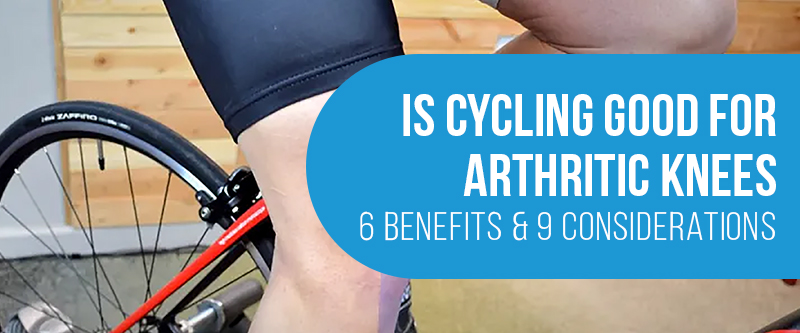You should be careful when cycling because it can put a lot of pressure on your knees. You risk knee injuries when cycling on rough terrain or using the wrong equipment.
Yes, cycling is beneficial for arthritic knees. It strengthens muscles around joints and produces synovial fluid, which lubricates them.
It helps improve your muscles, which support your knees, ankles, and feet. Cycling can also improve knee osteoarthritis outcomes.
In this blog post, we will explore whether cycling is good for arthritic knees, give tips to consider before you cycle with arthritis, and discuss the benefits of cycling for arthritic knees.
Is Cycling Good for Arthritic Knees? 6 Gains & 9 Tips

As we age, our joints wear down and become more prone to arthritis. The pain and discomfort in our knees can make even simple tasks overwhelming. Cycling is a great way to combat this pain, as it has several proven benefits for arthritic knees.
Low-affected Exercise
Cycling is a low-affected exercise, putting minimal stress on your joints. This is especially important if you have arthritic knees, as high-impact exercises such as running can exacerbate your symptoms. Cycling burns calories and increases your heart rate without putting unnecessary stress on your knees.
Increased Happy Hormones
Exercise has been proven to increase feel-good hormones like serotonin and endorphins. This can help to boost your mood and ease symptoms of depression and anxiety. Cycling is a fun form of exercise, so it can be a great way to improve your mental health and well-being.
Weight Control
It’s essential to stay healthy to manage symptoms of arthritis. Maintaining a healthy weight and burning calories through exercise helps you feel better knees. You can burn 500 calories per hour by cycling, depending on your speed and intensity.
Improved Overall Health
Physical activity is scientifically shown to enhance well-being and relieve illnesses like heart disease, diabetes, and stroke. Cycling builds muscle, boosts cardiovascular health, enhances balance and coordination, and adds an enjoyable element to staying fit and lowering the likelihood of falls.
Strengthens Lower Body Muscles
Pedal cycles strengthen the muscles in your lower body, including your quadriceps, hamstrings, and glutes. Stronger muscles can help to reduce the stress on your knee joints and improve your range of motion.
Increased Range of Motion
The disease can limit your range of motion and cause joint stiffness. Cycling carries a low risk of injury and improves range of motion to minimize knee stiffness. Regular cycling can help keep your joints mobile and enhance overall flexibility.
Arthritis and Cycling: 9 Things to Know
An excellent exercise for people with arthritis is cycling, as it is low-affected and can help improve joint mobility. Consider a few precautions before hopping on your bike and hitting the road.
Follow these precautions tips to ensure you get the most out of your cycling experience without exacerbating your arthritis pain.
Consult With Your Doctor

It is essential to consult with your doctor before starting cycling, especially if you have arthritis. Your doctor may recommend certain modifications to your cycling routine or suggest alternative forms of exercise.
Start With a Short Ride
Start with a low resistance for 5-10 minutes and accumulate the duration and intensity as you progress. You should exercise moderately for 150 minutes weekly, meaning 30 minutes, 5 times weekly.
If it’s easier on your joints, you can split that time into 10-minute intervals. To determine moderate intensity, you should be able to hold a conversation while exercising, even if your breathing rate increases.
Invest In a Good Bike
Investing in a high-quality bike well-suited for your needs and physical abilities can make a vast difference in your cycling experience. Consider purchasing a bike with wider tires, adjustable seats, and an upright posture to reduce strain on your joints.
Use Proper Cycling Routines
Using correct cycling techniques is crucial to prevent worsening arthritic pain. Ensure your knees stay aligned while pedaling, maintain a steady pace, and opt for lower gear when tackling hills.
Warm Up Before Cycling
Before starting your cycling routine, it is essential to warm up. Warm-up exercises, such as stretching, walking, or cycling for 5-10 minutes, can help to reduce the stiffness in your joints and increase your range of motion.
Wear Proper Clothing
When cycling, wear the proper clothing to reduce the chances of pain and stiffness. Wear padded shorts, comfortable shoes, and clothing layers you can easily remove or add as your body temperature changes.
Hydrate

It is essential to stay hydrated while cycling. The consumption of water helps to lubricate your joints and reduce inflammation in your body.
knee Brace
Knee braces can reduce knee pain and provide knee support for osteoarthritis. Different types of knee braces work differently for osteoarthritis. A brace may apply compression (pressure) to soft tissues, stabilize your knee, or redistribute your weight.
Conclusion
Biking can be an excellent way for people with arthritic knees to manage their symptoms. By engaging in regular low-affected exercise, patients may experience improved joint function, reduced pain, and enhanced quality of life.
The best way to prevent joint injury or damage is to seek medical care and use proper equipment to avoid common injury or harm. With guidance, cycling can be an excellent addition to a patient’s treatment plan and help them lead a healthy lifestyle despite their arthritis.
FAQs
Does Physical Therapy Help Arthritic Knees
Physical therapy can relieve arthritis pain and, more importantly, keep it at bay. Stretching and strengthening the muscles in the right way is crucial, so for example, strengthening the quadriceps, stretching the hip flexors, and often stretching the ITB.
Is There a Best Exercise For Arthritic Knees?
Low-affected exercises can help minimize joint stress while you move. Examples include stationary or recumbent cycling, elliptical trainer workouts, or water exercises. Use heat to relax joints and muscles and reduce pain before exercise.
What Kind of Bike Is Best For Arthritic Knees?
Electric bicycles are helpful for people who struggle with joint pain because of bad knees. E-bikes have pedal assist systems (PAS), so they can pedal independently. The e-bike motor helps move the bike forward when pedal assist is activated.


